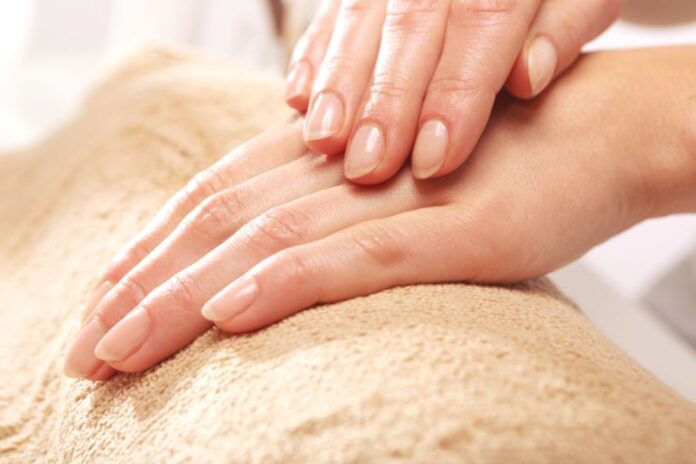We tend to consider our nails to be accessories—coatable canvases for self expression. But beneath the varnish is a richer tale: your nails can give away early hints about your inner health. From faint ridges to unexpected thickness or coloration, changes in nail texture can be your body’s way of whispering that something is amiss.
Nail texture and health are closely linked. Changes in your nails can signal everything from vitamin deficiencies to chronic illnesses. In this article, we’ll explore common nail abnormalities, what they may mean, and when it’s time to take them seriously.
Read More: What Fingernails Tell About Your Health? 12 Possible Facts
How Nails Reflect Your Overall Health
Nails grow from the nail matrix, a small pocket of tissue beneath the base of the nail. The health of this matrix—and the appearance of the nails it produces—is influenced by factors such as blood flow, nutrition, and systemic health.
As your nails grow (which is normally around 3 millimeters a month), they can start to show signs of what’s going on in your body. Changes in texture, color, and interruptions to growth often signal deeper problems earlier.
However, not everything that changes in your nails is bad. Some are cosmetic or just a sign of aging. But when the oddities persist or occur suddenly in your nails, it may signal a larger underlying problem.
Read More: How To Stop Biting Nails? 10 Ways To Get Rid Of This Bad Habit
Common Nail Texture Changes and What They Might Mean
Here are a few common nail texture changes that we must take note of:
a. Vertical Ridges (Longitudinal Lines)
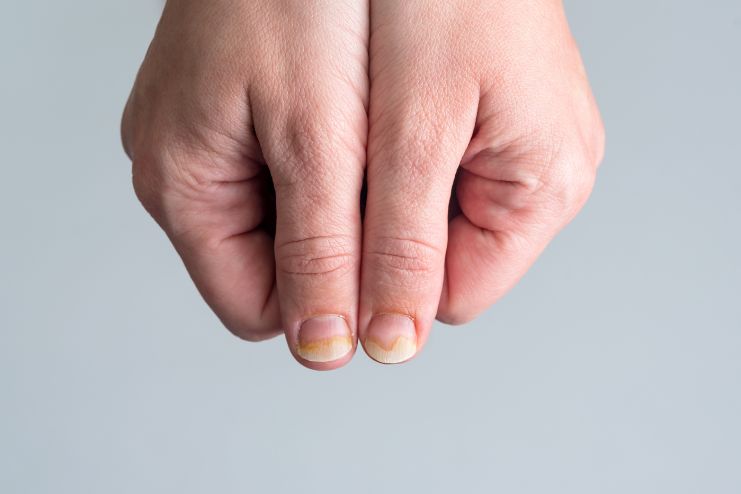
Vertical ridges are elevated lines that travel from the nail base to the tip. They usually appear as a normal aspect of aging, since the rate of cell turnover in the nail matrix decreases. But prominent or newly appearing ridges can indicate more than mere aging.
- Normal aging process, particularly in individuals aged over 50.
- Iron deficiency or anemia, especially if the nails are also thinning or brittle.
- Vitamin B12 deficiency can disrupt nail development and create a pale or irregular texture.
- Dehydration or malnutrition both of which reduce the production of keratin in the nail bed.
- Digestive diseases such as celiac or inflammatory bowel disease (IBD), which suppress nutrient intake and result in subtle nail alterations.
b. Horizontal Ridges (Beau’s Lines)
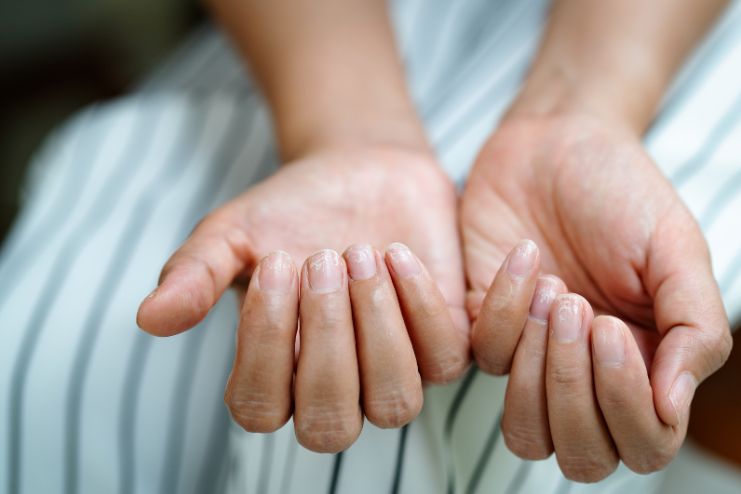
Beau’s lines are deep, horizontal grooves or indentations that extend across the nail plate. They typically happen when something halts nail growth at the matrix—like a severe illness, trauma, or systemic stressor. The depth and width of the line can even be used to estimate when the interruption happened.
- Severe infections, like COVID-19, pneumonia, or high fevers, which suspend nail production.
- Uncontrolled diabetes, which interferes with circulation and retards keratinization.
- Zinc deficiency disrupts normal nail development.
- Physical injury to the nail or matrix.
- Chemotherapy or radiation temporarily suspends growth in actively dividing cells, such as those in the nail bed.
- Major surgery or extreme emotional stress, which can shock the body sufficiently to leave a mark on the nails.
c. Brittle or Splitting Nails
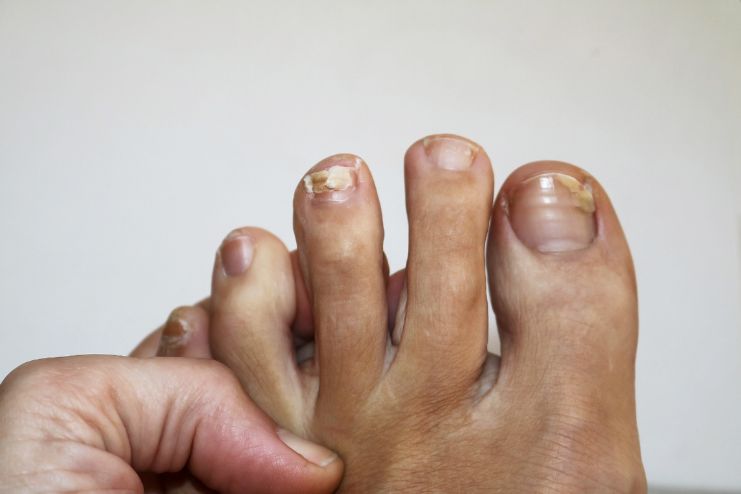
Splitting or breaking easily, peeling, or flaking is characteristic of brittle nails, which feel dry to the touch. Such changes usually indicate exterior wear and tear, but also can be a harbinger of systemic imbalance, particularly in conjunction with fatigue, loss of hair, or dry skin.
- Hypothyroidism, which diminishes circulation and decreases metabolic activity, compromises the integrity of the nails.
- Iron-deficiency anemia, typically associated with spoon-shaped nails or thin, brittle nails.
- Recurrent immersion in water, soaps, or abrasive detergents that remove the nail’s natural oils.
- Vitamin A, C, or biotin deficiency, which interferes with collagen and keratin production.
- Menopause or hormonal shifts can cause nails to become thinner over time.
- Cold winter weather and low humidity which dehydrate both nails and the skin around them.
d. Pitted Nails
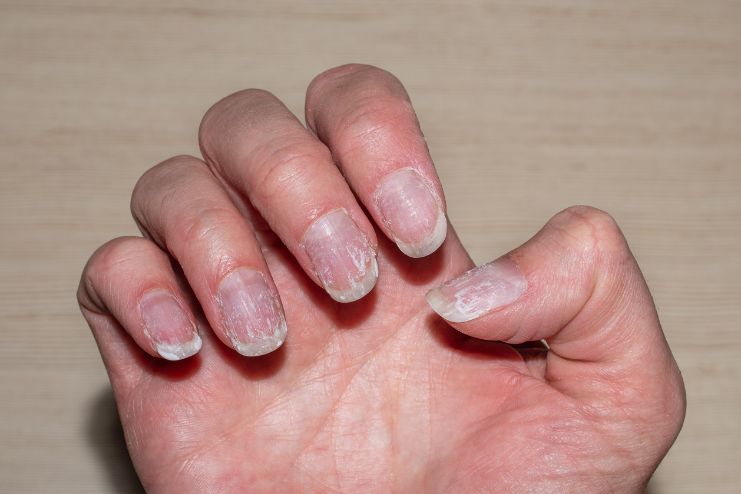
Nail pitting is minute depressions or dot-like indents on the nail plate’s surface. It indicates a change in the matrix of the nail where the nail is developed. Pitting is most commonly associated with autoimmune and inflammatory skin diseases.
- Psoriasis, in which 10–50% of affected patients present nail involvement before and/or during flare-ups.
- Alopecia areata, a condition in which there is autoimmunity affecting hair follicles and, less commonly, nails.
- Eczema or lichen planus, in which inflammation interferes with the normal shape of the nail.
- Reactive arthritis can cause identical pits accompanied by arthritis and skin manifestations.
- Fungal infections, although less frequent, can simulate pitting when the nail plate roughens.
e. Spoon-Shaped Nails (Koilonychia)
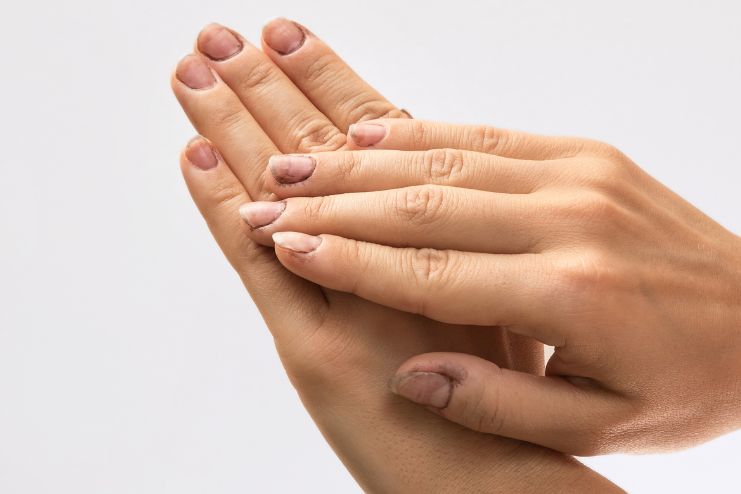
Koilonychia is used to describe soft, thin nails that are scooped out-looking—flat in the middle with edges that rise up. This particular shape generally indicates an oxygen-carrying or storage capacity deficiency of iron in the body and should be noted if associated with weakness or fatigue.
- Iron-deficiency anemia, the most prevalent cause, particularly in women who menstruate or who have chronic blood loss.
- Hemochromatosis, a hereditary disorder which leads to excess iron but is still capable of causing koilonychia owing to tissue destruction.
- Cardiovascular disease or circulatory inadequacy, which diminishes oxygen and nutrient delivery to the nails.
- Overexposure to chemicals, such as petroleum derivatives in some occupational exposures.
- Genetic cases in which the form of the nail is inherited but not associated with nutritional deficiency.
f. Thickened or Yellow Nails
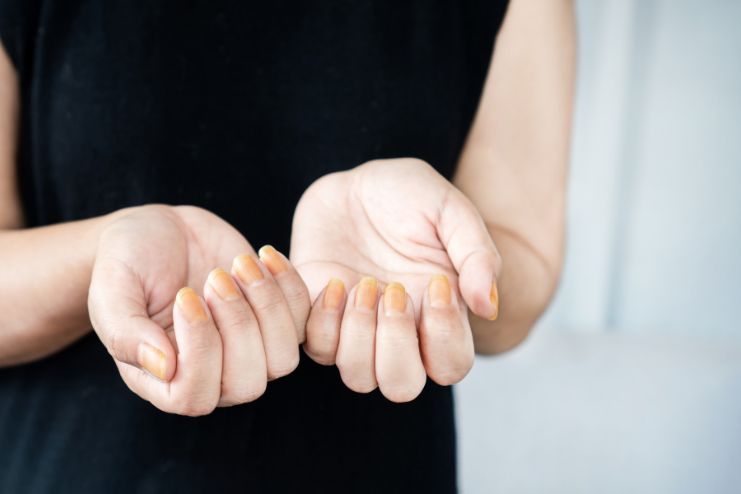
Thick, yellowish, or opaque nails usually suggest slow nail growth or accumulation under the nail. The change may begin with slight discoloration but evolve into a more severe condition if not treated.
- Fungal infections (onychomycosis), the most common cause of yellow, thick, and brittle nails.
- Yellow Nail Syndrome, an uncommon disorder frequently associated with respiratory disease and lymphatic dysfunction.
- Lung disease, particularly chronic bronchitis, can be associated with yellowing nails with excessive curvature.
- Lymphedema or circulatory insufficiency, which hinders nail growth and makes the nail bed thick.
- Psoriasis can also lead to thickened nails with a yellow or brown color and surface irregularities.
Read More: How to Remove Dead Toenails: Causes, Symptoms and Treatment
When to Be Concerned About Nail Texture
Some nail changes are harmless and reversible, but others are not. Be on the lookout for these red flags:
- Sudden change in the texture or appearance of several symptoms.
- Pain, swelling, discoloration, or lifting of the nail from the nail bed.
- Constant changes lasting over a month that keep worsening.
- Nail alterations that accompany fatigue, hair loss, or skin changes.
They could indicate an underlying systemic problem that requires a doctor’s attention.
What Can Affect Nail Texture (Besides Illness)?

Not all changes in nail texture are associated with disease. The following are other usual causes:
- Nail growth is naturally slowed, and ridging or brittleness may result with aging.
- Hormonal fluctuations, as seen with menopause, can change nail structure.
- Repetitive trauma, such as nail biting or harsh manicures, wears on the nail plate.
- Sudsy soaps, detergents, and prolonged wet exposure wear down nail strength.
- A poor diet with low biotin, protein, or iron content gradually reduces nail resilience.
Knowing the underlying cause allows you to differentiate between lifestyle-related problems and possible health issues.
Tips for Maintaining Healthy Nail Texture
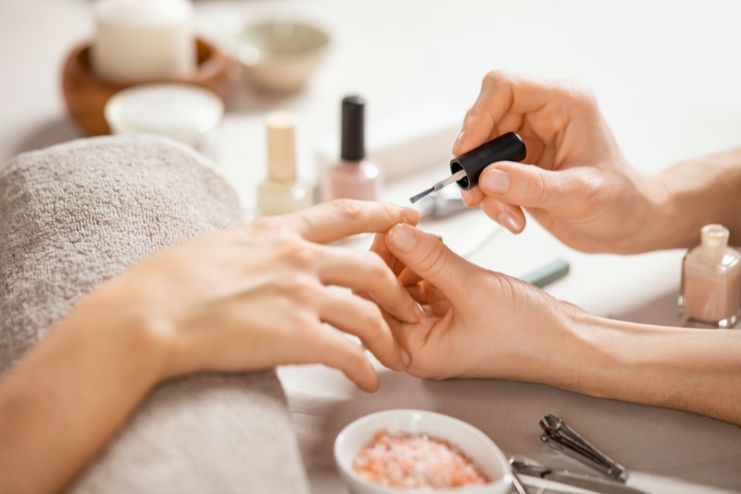
You can support strong, smooth nails with a few simple practices:
- Eat a balanced diet rich in nutrients like biotin, iron, zinc, and omega-3 fatty acids.
- Stay hydrated to support overall skin and nail health.
- Protect your nails with gloves during cleaning or when using chemicals.
- Moisturize nails and cuticles regularly to prevent brittleness.
- Limit harsh treatments like acrylics, excessive filing, or acetone-based removers.
Healthy nails grow from the inside out—so nutrition and care both matter.
When to See a Doctor or Dermatologist
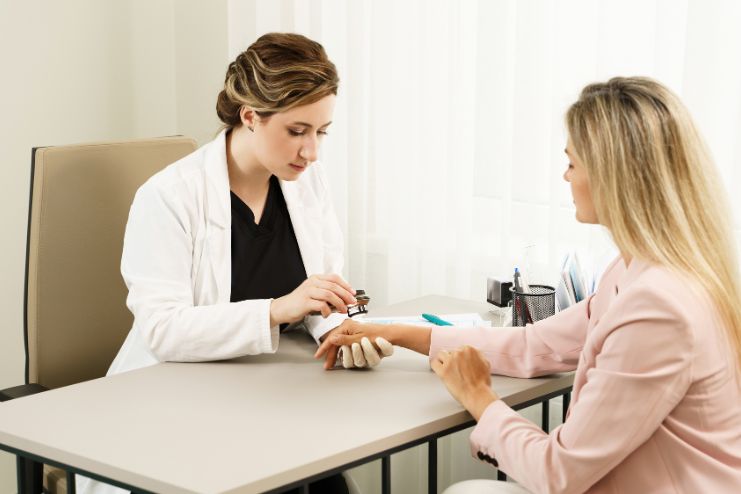
Not sure whether to worry about your nail changes? It’s best to consult a healthcare provider if:
- You have constant nail changes or pain.
- There is a suspected underlying disease like anemia, thyroid illness, or autoimmune disease.
- Your nail problems occur in conjunction with skin rashes, hair loss, or persistent fatigue.
A dermatologist may conduct tests or biopsies to determine causes and direct appropriate treatment.
Read More: How to Remove White Spots on Nails
Final Thoughts

Nail texture is more than skin deep—your nails reflect your inner health. Although not all ridges or dents signal trouble, your nails can be very revealing of your well-being.
By becoming aware of these nail health signals, you can act early, get medical advice when necessary, and have stronger, healthier nails for life. Listen to what your nails are saying—they might just lead you to discover a health problem before it’s serious.
References
- https://www.webmd.com/skin-problems-and-treatments/ss/slideshow-nails-and-health
- https://www.ncbi.nlm.nih.gov/books/NBK557760/
- https://www.ncbi.nlm.nih.gov/books/NBK559311/
- https://www.news-medical.net/health/Potential-Causes-of-Longitudinal-Ridging.aspx
- https://www.webmd.com/skin-problems-and-treatments/nail-pitting-causes
In this Article




![Best NAD+ Supplements for Energy, Aging, and Cellular Health [2025 Edition] Best NAD+ Supplements for Energy Aging](https://www.healthspectra.com/wp-content/uploads/2025/05/Best-NAD-Supplements-for-Energy-Aging-218x150.jpg)









